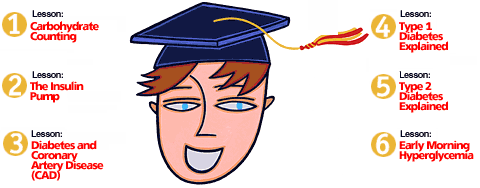



 |
|
|

|
|
Diabetes Lesson 4 - Type 1 Diabetes Explained 
Welcome to Diabetes 201 Lesson #1 - Type 1 Diabetes Explained By the end of this lesson, you'll be able to answer the following questions with ease:
Assignment #1
We tried to make it as straightforward as possible — promise. What was your score? Did you do better or worse than you thought you would? Either way, you are about to learn heaps about type 1 diabetes, so think of the quiz as a preview of how much knowledge you are about to gain. You can always take the quiz again at the end of the lesson. What is type I diabetes? Type 1 diabetes occurs when your body stops producing insulin or makes only a small amount. Insulin helps glucose enter your cells, which then burn the glucose for energy. With an inadequate supply or absence of insulin, glucose cannot enter your cells and collects in your blood instead. In the long run, high blood glucose levels can hurt your eyes, kidneys, nerves or heart. In order to compensate for this problem, you need to take insulin from an outside source to live healthily. What are the symptoms of type 1 diabetes? Before you are actually diagnosed with type 1 diabetes, you may have had many of the signs and symptoms of the disease for a while. Your doctor will check for the following symptoms: Frequent urination: This occurs because your kidneys cannot process all of the glucose in your bloodstream and must compensate by excreting the excess glucose in your urine. The glucose in your urine is so concentrated that water is absorbed from your blood right into your urine to decrease the glucose concentration. As long as your blood glucose level exceeds the kidneys' capacity to process it, the glucose and water will fill up your bladder repeatedly. Increased or constant thirst: Because of the increased concentration of glucose in your blood, your body senses that it needs more fluid intake to dilute the excess. This process, in combination with dehydration resulting from frequent urination, can cause increased or constant thirst. Weight loss: If your cells are not getting the glucose they need for energy, your body will begin to break down muscle and fat to burn for energy. This process can result in weight loss. Increased or constant hunger: Although you may eat sufficient calories, your cells aren't receiving the glucose to burn as energy. The malnourishment of your cells can lead to an increased or constant sense of hunger. Weakness and fatigue: The lack of glucose in your cells, the potassium loss from frequent urination and the breakdown of muscle for energy can leave you feeling weak and fatigued. Additionally, because of all the urinary excretion of fluid, people experience "postural hypotension," which can bring a feeling of lightheadedness and faintness upon suddenly standing up. Nausea and Vomiting: In a state of energy deprivation, the body will start to break down bodily fat for fuel. Ketone bodies are a product of this breakdown and will begin to build up in your blood and urine. Ketone bodies are acidic and can lead to nausea, abdominal pain and vomiting. Blurred Vision: As the lenses and retinas of your eyes are exposed to glucose-laden fluids, you can experience blurred vision. Diabetic Ketoacidosis: When your blood glucose rises to a dangerous level, your blood becomes viscous and circulates poorly. The addition of frequent urination and vomiting causes fluid loss and pulls important substances like sodium and potassium out of your body. All of these factors can result in extreme drowsiness or unconsciousness. This state is called diabetic ketoacidosis, which can be fatal if not treated promptly. Page 1 2 3 4 Copyright © 1999-2025 savvyHEALTH.com. All rights reserved.
|
|
|
||||||||||||||||
|
About savvyHEALTH | Privacy | Feedback | Home
http://www.savvyHEALTH.com/
All contents copyright © 1999-2025 savvyHEALTH, Inc. All rights reserved.
This internet site provides information of a general nature and is
designed for educational purposes only. If you have any concerns about
your own health, you should always consult
with a physician or other healthcare professional. Please review the Terms of Use before using this site. Your use of the site indicates your agreement to be bound by the Terms of Use.
|
|